A circuit that provides a sweep along the diagonal axis of any oscilloscope. Encyclopedia of radio electronics and electrical engineering

Encyclopedia of radio electronics and electrical engineering / Radio amateur designer
 Comments on the article
Comments on the article
A scheme has been developed that makes it possible to obtain a diagonal deviation regardless of the existing vertical and horizontal deviation channels. As a result, using any oscilloscope, instead of the usual two-coordinate waveforms in the X-Y plane, you can get a truly three-dimensional image. The resulting XNUMXD display with X, Y, Z axes creates an amazing XNUMXD effect without any modification to the oscilloscope. The new device makes it possible to study three-parameter curves and three-frequency Lissajous figures, obtain three-dimensional images of signs, and can also be used in various visual indicators.
For diagonal deflection, the input diagonal deflection signal is simultaneously applied to the inputs of the vertical and horizontal deflection amplifiers. The result is the well-known Lissajous figure for common-mode signals, namely a 45° line. Op-amps A1 and A2 decouple the diagonal input from the vertical and horizontal inputs, and op-amps A3 and A4 add the diagonal components to the vertical and horizontal inputs, respectively. The gains of the operational amplifiers A1 and A2 are regulated in a certain way, since the angle of inclination of the diagonal axis is directly proportional to their ratio. Adjustment of the three input circuits provides separate control of the sensitivity of all three channels.
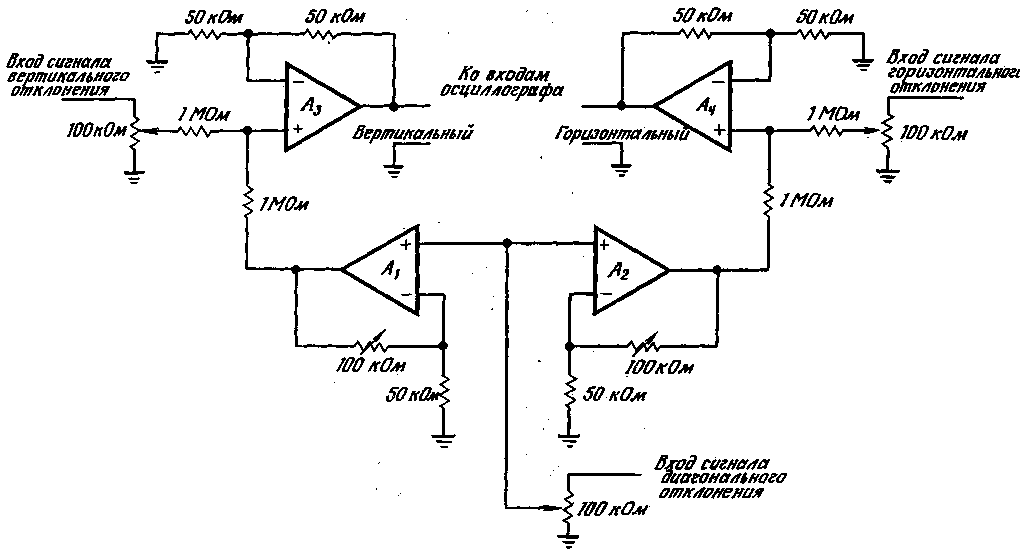
Rice. 1 (click to enlarge)
Four operational amplifiers provide a diagonal beam deflection and create a depth effect on the screen of a conventional oscilloscope. Two amplifiers serve to decouple the diagonal deflection signal input from the vertical and horizontal deflection inputs, and the other two sum these signal components to control the beam deflection.
All four op amps should have identical characteristics and equal compensation circuits, especially when operating at high frequencies. Otherwise, for example, if the phase shifts in the two arms of the diagonal deviation channel are not equal, the diagonal line is converted to an ellipse. Obviously, the best way to achieve identical performance is to use a quad op-amp. Also, since the signal from the circuit is connected to the external input of the oscilloscope's horizontal amplifier, the signal from the internal horizontal generator (if required) must be connected from the oscilloscope's output jack to the new horizontal input.
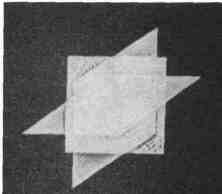

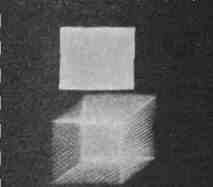
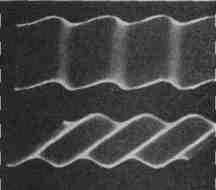
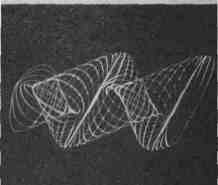
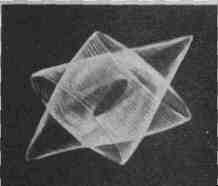
Fig. 2
The XNUMXD display (top left) illustrates the three beam deflection planes: X-Y, YZ and X-Z. Top right shows a XNUMXD Lissajous figure in the form of a circle, below its XNUMXD image in the form of a cylinder. A square raster, when scanned diagonally, is converted into a cube (middle left). Two sinusoidal oscillations when scanned along the third coordinate (vertically) form two wavy surfaces in the X-Z and X-Y planes, respectively (middle right). Volumetric images of Lissajous figures of complex shape (below).
Literature
- K. Lanz. Circuit adds diagonal axis to any scope, p. 126.
Author: N. Lanz; Publication: N. Bolshakov, rf.atnn.ru
 See other articles Section Radio amateur designer.
See other articles Section Radio amateur designer.
 Read and write useful comments on this article.
Read and write useful comments on this article.
<< Back
 Latest news of science and technology, new electronics:
Latest news of science and technology, new electronics:
A New Way to Control and Manipulate Optical Signals
05.05.2024
The modern world of science and technology is developing rapidly, and every day new methods and technologies appear that open up new prospects for us in various fields. One such innovation is the development by German scientists of a new way to control optical signals, which could lead to significant progress in the field of photonics. Recent research has allowed German scientists to create a tunable waveplate inside a fused silica waveguide. This method, based on the use of a liquid crystal layer, allows one to effectively change the polarization of light passing through a waveguide. This technological breakthrough opens up new prospects for the development of compact and efficient photonic devices capable of processing large volumes of data. The electro-optical control of polarization provided by the new method could provide the basis for a new class of integrated photonic devices. This opens up great opportunities for ... >>
Primium Seneca keyboard
05.05.2024
Keyboards are an integral part of our daily computer work. However, one of the main problems that users face is noise, especially in the case of premium models. But with the new Seneca keyboard from Norbauer & Co, that may change. Seneca is not just a keyboard, it is the result of five years of development work to create the ideal device. Every aspect of this keyboard, from acoustic properties to mechanical characteristics, has been carefully considered and balanced. One of the key features of Seneca is its silent stabilizers, which solve the noise problem common to many keyboards. In addition, the keyboard supports various key widths, making it convenient for any user. Although Seneca is not yet available for purchase, it is scheduled for release in late summer. Norbauer & Co's Seneca represents new standards in keyboard design. Her ... >>
The world's tallest astronomical observatory opened
04.05.2024
Exploring space and its mysteries is a task that attracts the attention of astronomers from all over the world. In the fresh air of the high mountains, far from city light pollution, the stars and planets reveal their secrets with greater clarity. A new page is opening in the history of astronomy with the opening of the world's highest astronomical observatory - the Atacama Observatory of the University of Tokyo. The Atacama Observatory, located at an altitude of 5640 meters above sea level, opens up new opportunities for astronomers in the study of space. This site has become the highest location for a ground-based telescope, providing researchers with a unique tool for studying infrared waves in the Universe. Although the high altitude location provides clearer skies and less interference from the atmosphere, building an observatory on a high mountain poses enormous difficulties and challenges. However, despite the difficulties, the new observatory opens up broad research prospects for astronomers. ... >>
 Random news from the Archive Random news from the Archive Electricity from sea lettuce
02.01.2022
Researchers at the Technion - the Israel Institute of Technology - have developed a new method to generate electrical current directly from seaweed in an environmentally friendly and efficient way.
The idea, which first occurred to Technion doctoral student Yaniv Schlosberg while swimming on the beach, was brought to fruition by a team of researchers from three Technion faculties that are members of the Technion's Large Energy Program (GTEP), along with a researcher from the Israel Institute of Oceanography and Limnology in Haifa (IOLR). ).
As is known, the combustion of fossil fuels leads to the emission of greenhouse gases and other pollutants that affect climate change, and various forms of environmental pollution occur at all stages of production, transportation, processing and consumption of these fuels. The climate crisis and environmental issues are driving the research and search for alternative, clean and renewable energy sources. One of them is the use of living organisms (eg bacteria) as a current source in microbial fuel cells (MFC) and BPEC biophotovoltaic cells. Some bacteria have the ability to transfer electrons, but they need to be constantly fed, and some of them are pathogenic.
An alternative source of electricity could be photosynthetic bacteria, especially cyanobacteria (also known as blue-green algae). Cyanobacteria themselves get their food from carbon dioxide, water and sunlight, and in most cases they are harmless - some of them, such as "spirulina", are generally considered "superfoods" and are grown in large quantities.
The research teams of professors Noam Adir and Gadi Schuster have already developed methods for using cyanobacteria to generate electricity and hydrogen fuel. However, cyanobacteria also have disadvantages - they produce less current in the dark, when there is no photosynthesis, and the energy received from them is less than from conventional solar cells. Therefore, BPEC technology, although more environmentally friendly, is less commercially attractive.
In their new work, researchers from the Technion and IOLR have tried to solve this problem using a new source of photosynthesis - algae. The study was led by Prof. Noam Adir and doctoral student Yaniv Schlosberg from the Technion Department of Chemistry and GTEP. They collaborated with other Technion researchers: Dr. Tunde Toth (Department of Chemistry), Prof. Gadi Shuster, Dr. David Merii, Nimrod Krupnik and Benjamin Eichenbaum (Department of Biology), Dr. Omer Yehezkeli and Matan Meyrovic (Department of Biotechnology and Food Engineering) and Dr. Alvaro Israel from IOLR in Haifa. Many types of seaweed grow naturally on Israel's Mediterranean coast - especially ulva (also known as sea lettuce), which is grown in large quantities at IOLR for research purposes.
By developing new ways to connect algae and BPEC, the researchers have obtained a current that is 1000 times stronger than that from cyanobacteria, and is at the level of standard solar cells. Professor Adir notes that this current strength is due to the high rate of photosynthesis of algae and the ability to use algae in their natural seawater as an electrolyte in BPEC. In addition, seaweed creates current in the dark, generating about 50% of the current in the light - in the dark, the energy source is algae respiration, in which the sugars obtained during photosynthesis are used for nutrition. As with cyanobacteria, no additional chemicals are required to produce the current. "Sea lettuce" releases intermediary molecules to carry electrons to the BPEC electrode, thus creating an electrical current.
Energy production technologies based on fossil fuels are known as "carbon positive". This means that when fuel is burned, carbon is released into the atmosphere. Solar cell technologies are known as "carbon neutral" and when they extract energy from the sun, no new carbon is really released into the atmosphere. However, the production of solar cells and their transportation to the place of use is many times more carbon-positive. The new bioelectricity technology developed at the Technion is truly "carbon negative" - seaweed grows by absorbing atmospheric carbon during the day and releasing oxygen, and only at night they release carbon when they breathe. At the same time, seaweeds are already being cultivated on a mass scale for the food, cosmetic and pharmaceutical industries.
|
 Other interesting news:
Other interesting news:
▪ Gadget for kissing at a distance
▪ Electric barrier to protect swimmers from sharks
▪ Australian city powered by solar energy
▪ Self-service bike taxi
▪ Notebooks Samsung Galaxy Book3 Pro, 360 and Pro 360
 News feed of science and technology, new electronics
News feed of science and technology, new electronics
 Interesting materials of the Free Technical Library:
Interesting materials of the Free Technical Library:
▪ section of the site Wonders of nature. Article selection
▪ article Living corpse. Popular expression
▪ article Why football fans shout: Shai-boo! Shai-boo!? Detailed answer
▪ article Loch silvery. Legends, cultivation, methods of application
▪ article Combination lock control module. Encyclopedia of radio electronics and electrical engineering
▪ article Transceiver YES-97. Encyclopedia of radio electronics and electrical engineering
 Leave your comment on this article:
Leave your comment on this article:
 All languages of this page
All languages of this page
Home page | Library | Articles | Website map | Site Reviews

www.diagram.com.ua
2000-2024







 Arabic
Arabic Bengali
Bengali Chinese
Chinese English
English French
French German
German Hebrew
Hebrew Hindi
Hindi Italian
Italian Japanese
Japanese Korean
Korean Malay
Malay Polish
Polish Portuguese
Portuguese Spanish
Spanish Turkish
Turkish Ukrainian
Ukrainian Vietnamese
Vietnamese







 Leave your comment on this article:
Leave your comment on this article: